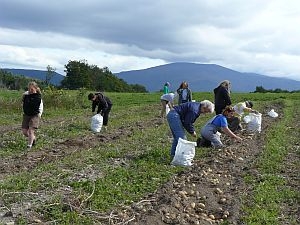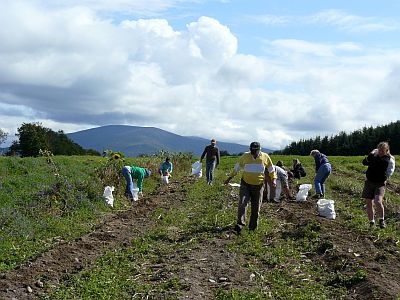
(Host) An estimated 96 billion pounds of food are wasted in this country every year. That’s more than a quarter of our total food output.
For years the Vermont Foodbank has worked to prevent that waste wherever possible and redirect it to where it’s needed in our region.
Recently – to capture some of the mounds of fresh fruits and vegetables that go unused — they’ve revived an ancient custom that’s been making a comeback: gleaning.
VPR’s Susan Keese tagged along on one gleaning expedition at a farm center in Rupert.
(Keese) The mention of food shelves tends to conjure up images of canned goods and packaged soups and rice.
(Sfx) volunteers milling (Snow, ‘So again, just everything on the surface) (ambi continues under)
(Keese) But the volunteers assembling on this hilltop field in Rupert have *earthier fare in mind. They’re here to harvest potatoes.
(Snow(with others) "Hi Don! How are you…"
(Keese) The spuds are being donated by the Merck Forest and Farmland Center. One of 87 farms the Foodbank has worked with since it formally adopted its gleaning program in 2008.
Theresa Snow, the Foodbank’s Director of Agricultural resources, scans the rows where the potatoes have been lifted to the surface in preparation for today’s harvest.
(Snow) "I’m guessing two to three thousand…"
(Keese) That’s two to three thousand *pounds of potatoes. Snow and her volunteers were here two weeks ago and came away with 1,300 pounds of garlic, cabbage and cucumbers.

That’s only a fraction of the produce that Merck sells in wholesale and retail markets. But Snow says it’s welcome food when the Foodbank’s six trucks hit the road each week to deliver to partner agencies.
(Snow) "Food shelves and food pantries, senior meal sites, some after school programs like kids cafes, some preschool programs, different shelters of sorts."
(Keese) Snow says gleaning is a practice that goes back to Old Testament times.
(Snow) "Traditionally gleaning occurred when a property owner would leave just the edge of their field closest to a road or traveling lane, available for those travelers, homeless or poor, so they could just pick a little for themselves. I think the Biblical verse says not to harvest to the very edge of your field and to leave them for the traveler and sojourner."
(Keese) Sometimes gleaners collect what’s left behind by farm machines after the harvest. Other times it’s food that’s cosmetically unmarketable. But these potatoes are mostly perfect.
(Potato picking sounds)
The gleaners get right to work filling their gunny sacks. Some of the Merck staff help, too. The center runs a 300-acre educational farm and CSA. Greg Stevens is the farm manager.
(Stevens) "We always grow a little bit extra because we want our interns and apprentices to get production experience… so that everybody gets a chance to ride the cultivating tractor and everybody gets a chance to run the lifter. Plus with the economic situation we thought it would be a good idea for us to develop a relationship with the Vermont Foodbank."
(Picking sounds)
(Almquist) "It’s just really exciting to see gleaning starting to take off around the country as this new but ancient practice of making sure local, fresh produce is eaten by everyone."
(Keese) Corinne Almquist, a recent Middlebury College grad, has a fellowship to promote gleaning around Vermont.
(Almquist) "I think people are really starting to look at it as a way that we can sort of close the loop and build these local food economies that really include people of all economic strata."
(Schweisthal) "Hey if there’s food out here and people need it, there’s no excuse to leave it to rot!"
(Keese) Don Schweisthal is a retired highway worker. Working next to him is Elaine Eisenburg, the Merck Center’s Executive Director.
(Keese) Eisenburg wipes the dirt off each potato she drops into her sack. She says there’s no reason to weigh down the bag with anything but potatoes.
Theresa Snow says she’s happy to leave a little soil on the vegetables.
(Snow) "I think it’s a great way to connect people with where food comes from – grown in the soils, so it kind of get them involved and they take it home and give it a quick wash and they can acknowledge that it came from the farm."
(Keese) Snow says the future of Vermont agriculture, and our nation’s food security, depend on that kind of appreciation.
For VPR News, I’m Susan Keese.